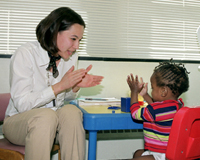![]()

“A Fresh Start for High-Risk Children”
Christine Reiner Hess, a Ph.D. student in UMBCs applied developmental psychology graduate program, helps high-risk children get a fresh start at life.
Hess has always had a strong interest in child psychology. When she read about the child intervention work that Douglas Teti, professor of psychology at UMBC, was conducting, she knew she wanted to work in applied developmental psychology.
At the time, Teti was studying how mothers adjusted after giving birth to infants hospitalized in a neonatal intensive care unit due to prematurity and low birth weight. I was fortunate to be able to join the project and complete my masters thesis from the findings, says Hess. For her thesis, Hess examined the role of personal and professional support in mothers adjustment to their medically at-risk infants, and the moderating effect of child characteristics in predicting maternal adjustment.
The applied developmental psychology program at UMBC has helped me gain valuable clinical and research experience through my practicum and research opportunities. The program is flexible; Im able to choose specialty classes and experiences that allow me to learn about and work with high-risk populations of children, says Hess.
The programs focus on in-depth practicum experiences gives students such as Hess opportunities to define their areas of interests through hands-on, applied research experiences. Currently, Hess works with infants and toddlers in the Neonatal Intensive Care Unit Follow-up Clinic at the University of Maryland Medical System (UMMS). She conducts developmental assessments with high-risk, preterm and low-birth-weight infants and toddlers.
For her dissertation, Hess is examining whether a biological versus environmental risk index is a better predictor of child development in the first few months of life for medically at-risk infants. In addition, she is examining how maternal confidence and maternal knowledge of infant development predict the quality of mother-infant play interactions. After receiving her Ph.D. in May, Hess plans to continue her work with at-risk children at UMBC through a post-doctoral research position.
